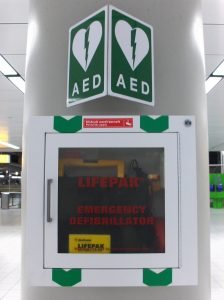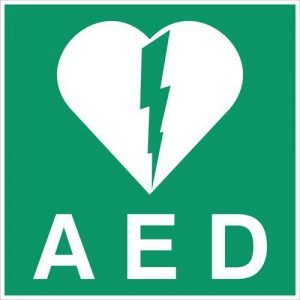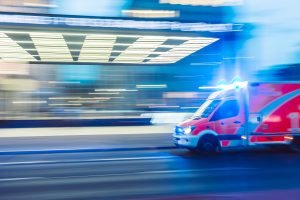Sudden cardiac arrest kills almost half a million people every year in the United States, and is the leading cause of death in Americans over 40. Different from heart attacks, which result from arterial issues like plaque buildup and blockages, cardiac arrest is an “electrical problem” which occurs “suddenly and without warning… triggered by an electrical malfunction in the heart that causes an irregular heartbeat,” according to the American Heart Association.
 And with this electrical problem comes an electrical solution: the Automatic External Difibrillator, or AED. This small, automated, lightweight device sends an electrical pulse through the victim’s chest, jolting their heart back to its stable rhythm. In the event a person collapses from a cardiac event, use of an AED is an integral part of the victim’s survival. In fact, per the AHA’s Emergency Treatment of Cardiac Arrest checklist, the very first step a bystander to take is to assign one person to call 911, and another to go retrieve the nearest AED.
And with this electrical problem comes an electrical solution: the Automatic External Difibrillator, or AED. This small, automated, lightweight device sends an electrical pulse through the victim’s chest, jolting their heart back to its stable rhythm. In the event a person collapses from a cardiac event, use of an AED is an integral part of the victim’s survival. In fact, per the AHA’s Emergency Treatment of Cardiac Arrest checklist, the very first step a bystander to take is to assign one person to call 911, and another to go retrieve the nearest AED.
This is why it’s important to be familiar with the location of AEDs in public places you visit frequently. The National Heart, Lung, and Blood Institute notes that AED’s are often found in public centers where large numbers of people tend to gather, such as
- shopping malls
- golf courses
- gyms and swimming pools
- businesses
- airports
- hotels
- sports venues
- schools
 When visiting places like these, it’s a good idea to take note of the AED’s location when you pass through. While they are marked with specific signs, like the symbol here to the left, they can be difficult to track down in the panic of an emergency. Imagine being told be a stranger to quickly go retrieve the AED. You want to help, so you rush into action, but then realize you don’t know where you’re going. These high stress situations can cause unnecessary delays, and it’s in these moments when seconds can mean life or death.
When visiting places like these, it’s a good idea to take note of the AED’s location when you pass through. While they are marked with specific signs, like the symbol here to the left, they can be difficult to track down in the panic of an emergency. Imagine being told be a stranger to quickly go retrieve the AED. You want to help, so you rush into action, but then realize you don’t know where you’re going. These high stress situations can cause unnecessary delays, and it’s in these moments when seconds can mean life or death.
The optimal response time is all within minutes of the victim’s collapse, according to AED.com. Fortunately, modern AED’s provide detailed instruction to users, and the process is mostly automated.
“The AED communicates with the user both audibly and visually, gives CPR feedback, and analyzes the victim’s heart rhythm. If a shock is advised, the AED automatically delivers the shock to the victim’s heart which resets the heart rhythm and allows the SCA victim’s heart to start pumping blood again.”
 If there is no AED on site, CPR should be performed continuously until emergency medical services arrive, but without the electric shock to the heart, the victim is unlikely to survive more than five minutes. According to a Reuter’s report, “on average in the U.S., the length of time between a call for help and the arrival of emergency medical services is about eight minutes.” This can go up to twelve minutes in rural areas. This is why it is important to ensure that AED’s are prevalent, accessible, and clearly marked throughout your community, and even in your own home.
If there is no AED on site, CPR should be performed continuously until emergency medical services arrive, but without the electric shock to the heart, the victim is unlikely to survive more than five minutes. According to a Reuter’s report, “on average in the U.S., the length of time between a call for help and the arrival of emergency medical services is about eight minutes.” This can go up to twelve minutes in rural areas. This is why it is important to ensure that AED’s are prevalent, accessible, and clearly marked throughout your community, and even in your own home.
Training to respond to a cardiac emergency and having an AED nearby is the best way to prevent tragedy. Our classes at Safety & Health Solutions will provide you the knowledge and confidence to act quickly in case an emergency strikes near you. These can happen to unexpected people at unexpected times, so preparedness is key. To get an AED for your home, business, gym, place of worship, or anywhere you notice is not prepared with a device, simply give us a call at 404-380-1510 and we will make sure that your needs are met! With the technology available to us today, there’s no excuse to not be prepared for these situations which arise every single day.

Recent Comments